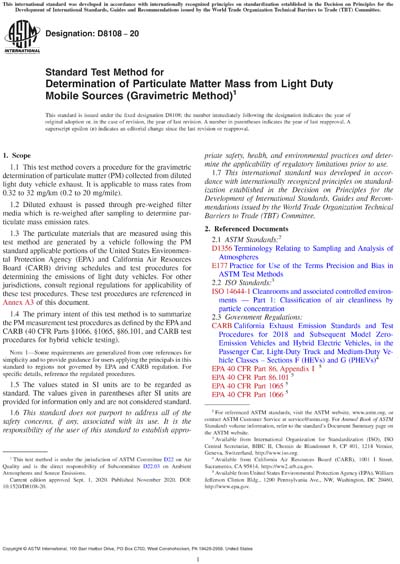Historical
ASTM D8108-20
Standard Test Method for Determination of Particulate Matter Mass from Light Duty Mobile Sources (Gravimetric Method)
1.1 This test method covers a procedure for the gravimetric determination of particulate matter (PM) collected from diluted light duty vehicle exhaust. It is applicable to mass rates from 0.32 to 32 mg/km (0.2 to 20 mg/mile).
1.2 Diluted exhaust is passed through pre-weighed filter media which is re-weighed after sampling to determine particulate mass emission rates.
1.3 The particulate materials that are measured using this test method are generated by a vehicle following the PM standard applicable portions of the United States Environmental Protection Agency (EPA) and California Air Resources Board (CARB) driving schedules and test procedures for determining the emissions of light duty vehicles. For other jurisdictions, consult regional regulations for applicability of these test procedures. These test procedures are referenced in Annex A3 of this document.
1.4 The primary intent of this test method is to summarize the PM measurement test procedures as defined by the EPA and CARB (40 CFR Parts §1066, §1065, §86.101, and CARB test procedures for hybrid vehicle testing).
Note 1: Some requirements are generalized from core references for simplicity and to provide guidance for users applying the principals in this standard to regions not governed by EPA and CARB regulation. For specific details, reference the regulated procedures.
1.5 The values stated in SI units are to be regarded as standard. The values given in parentheses after SI units are provided for information only and are not considered standard.
1.6 This standard does not purport to address all of the safety concerns, if any, associated with its use. It is the responsibility of the user of this standard to establish appropriate safety, health, and environmental practices and determine the applicability of regulatory limitations prior to use.
1.7 This international standard was developed in accordance with internationally recognized principles on standardization established in the Decision on Principles for the Development of International Standards, Guides and Recommendations issued by the World Trade Organization Technical Barriers to Trade (TBT) Committee.
Content Provider
ASTM International [astm]






